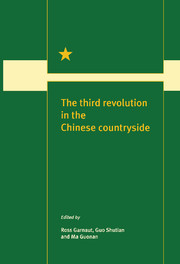Book contents
- Frontmatter
- Contents
- Figures
- Maps
- Tables
- Contributors
- Preface
- 1 The third revolution
- Feeding the people
- Marketing and price reform
- Internationalisation
- Regional issues
- Institutional change
- 18 China's rural property rights system under reform
- 19 ‘All the tea in China’: the reformation and transformation of the tea industry
- 20 The growth of rural industry: the impact of fiscal contracting
- References
- Index
18 - China's rural property rights system under reform
from Institutional change
Published online by Cambridge University Press: 04 August 2010
- Frontmatter
- Contents
- Figures
- Maps
- Tables
- Contributors
- Preface
- 1 The third revolution
- Feeding the people
- Marketing and price reform
- Internationalisation
- Regional issues
- Institutional change
- 18 China's rural property rights system under reform
- 19 ‘All the tea in China’: the reformation and transformation of the tea industry
- 20 The growth of rural industry: the impact of fiscal contracting
- References
- Index
Summary
In 1992 China defined the end point of reform as establishing a ‘socialist market economy’. One of the essential conditions for a market economy is clear definition of property rights. This chapter proposes a new property rights system in China's rural economy.
Chinese Vice-Premier Zhu Rongji defined the objectives of economic policy in a socialist market economy at the Opening Ceremony of the 11th Session of the Interaction Council on 13 May 1993: ‘The essence of a socialist economy includes two points. One is to achieve high efficiency of resource allocation and high labour productivity; and the other is to safeguard social fairness and realise the common welfare’.
At the core of an economic system there are two fundamental institutional arrangements: the property rights system, and economic contracts determined by the corresponding property rights system. A property rights system requires that the whole society or some of its individuals possess the entire property of the society or a defined part of it. Property here includes natural resources, human capital, technology, fixed assets and financial assets.
A property rights system is better the lower the operation or transaction costs. Transaction costs include the costs incurred in reallocating and protecting property, and in contract design and enforcement. To reduce transaction costs in an economy, the property rights system should not hinder competitive resource allocation and utilisation in economic activities. Transaction costs can be reduced through market competition.
- Type
- Chapter
- Information
- The Third Revolution in the Chinese Countryside , pp. 255 - 260Publisher: Cambridge University PressPrint publication year: 1996



